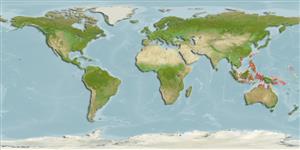Common names from other countries
Environment: milieu / climate zone / depth range / distribution range
Ecología
marino demersal; rango de profundidad 0 - 1 m (Ref. 90102). Tropical
Distribución
Países | Áreas FAO | Ecosistemas | Ocurrencias, apariciones | Point map | Introducciones | Faunafri
Western Pacific: Hsiao-liu-chiu Island, off southwestern Taiwan; south to Kur Island, Indonesia.
Tamaño / Peso / Age
Maturity: Lm ? range ? - ? cm
Max length : 7.0 cm SL macho / no sexado; (Ref. 9962); 5.5 cm SL (female)
Short description
Claves de identificación | Morfología | Morfometría
Espinas dorsales (total) : 12 - 14; Radios blandos dorsales (total) : 19 - 21; Espinas anales: 2; Radios blandos anales: 21 - 23. Dorsal fin XII-XIV, 19-21; membrane between spinous and segmented-ray portions notched deeper than half length of first segmented ray; membrane from posteriormost ray beginning from between dorsal edge of caudal peduncle at caudal-fin base (rarely) to dorsal edge of caudal fin up to 18% caudal-fin length in specimens ? 3 cm SL; anal fin II, 21-23 (23 only in males); pectoral-fin rays 13-14; vertebrae 10+27 to 30 = 37 to 40 (rarely 40); lacking nape cirrus; orbital cirrus simple, rarely a single branch or a few short, fine filaments at tip, typically shorter than orbital diameter; nasal cirrus simple, relatively long (typically half orbital diameter); lateral line canal continuous anterodorsally with simple pores (no vertical pairs), extending posteriorly to between verticals from bases of 6th and 9th dorsal-fin spines (usually to between verticals from 7th and 8th spines), then continuing posteriorly and posteroventrally as series of 1-6 (rarely 1 or 6) short, disconnected, horizontally bi-pored canals/tubes in skin; posteriormost tube area below and between verticals from bases of 7th spine and second segmented dorsal-fin ray (rarely posterior to vertical from 12th spine); mandibular pores 3-5; lacking posterior canines; ventral margin of upper lip and dorsal margin of lower lip entire; both sexes from ?3 cm SL with well-developed, fleshy, blade-like crest on dorsal part of head; crest of females comparatively smaller than males’; spinous portion of dorsal fin dusky, crossed by several diagonal, paler-dusky stripes with dark margins; segmented ray portion faint dusky with numerous dark pinstripes coursing length of fin, stripes coalescing into reticular pattern posteriorly. Male max. size ca 7 cm SL; female max. size ca 5.5 cm.
Facultative air-breathing (Ref. 126274); Adults occur in tide pools and close to edge of rocky shores at low tide. Oviparous. Eggs are demersal and adhesive (Ref. 205), and are attached to the substrate via a filamentous, adhesive pad or pedestal (Ref. 94114). Larvae are planktonic, often found in shallow, coastal waters (Ref. 94114).
Life cycle and mating behavior
Maturities | Reproducción | Spawnings | Egg(s) | Fecundities | Larva
Oviparous, distinct pairing (Ref. 205).
Springer, V.G. and J.T. Williams, 1994. The Indo-West Pacific blenniid fish genus Istiblennius reappraised: a revision of Istiblennius, Blenniella, and Paralticus, new genus. Smithson. Contrib. Zool. 565:1-193. (Ref. 9962)
IUCN Red List Status (Ref. 130435)
CITES (Ref. 128078)
Not Evaluated
Threat to humans
Harmless
Human uses
Herramientas
Warning: mysqli::__construct(): (08004/1040): Too many connections in /var/www/html/includes/speciessummary.lib.php on line 2104
Can't connect to MySQL database fbquizv2. Errorcode: Too many connections
